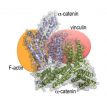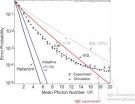(Press-News.org) JUPITER, FL, January 6, 2012 – Scientists know that cells in all higher organisms cells need to bind to each other for the development, architecture, maintenance and function of tissues. Mysteries have remained, however, about exactly how cells manage this feat.
Scientists from the Florida campus of The Scripps Research Institute (TSRI) have now solved part of this puzzle by defining the structure of a protein known as α-catenin, which is essential to this process.
The work was published online ahead of print on January 6, 2012, by the journal Nature Structural & Molecular Biology.
Chain, Chain, Chain
Our cells bind to each other using specialized cell surface adhesion complexes called adherens junctions, which direct the formation of tight, Velcro-like contacts among cells.
Adherens junctions are made up of three types of proteins—cadherin, α-catenin and β-catenin. First, cadherin receptors, which span the cell membrane, direct the binding of cells to each other using domains that project outside the cell. Second, their tail domains, found on the inside of the cell, bind to the protein β-catenin, which, in turn, is bound to α-catenin.
The term catenin is derived from the Latin word for chain, catena, and these three proteins literally make a chain.
This complex is then stabilized when the end of the chain, α-catenin, attaches to the molecular framework of the cell, the cytoskeleton. Without this, link cells would simply be amorphous piles of goo. Furthermore, alterations of cadherins, β-catenin and/or α-catenin can lead to marked changes in cell signaling, growth and migration—which can result in abnormalities and cancer.
Confronting a Paradox
Exactly how α-catenin provides links to the cytoskeleton and to the cadherin-β-catenin complex, however, has long puzzled scientists.
Scientists have known that α-catenin forms links to the cytoskeleton by binding to a protein called F-actin (the "F" stands for filament), which is found in species ranging from yeast to humans. The paradox for scientists has been that, despite being able to bind to F-actin on its own, when bound to α-catenin α-catenin cannot bind to F-actin. That is, the binding of α-catenin to F-actin and to β-catenin are, in the test tube, mutually exclusive. So how does α-catenin bind to F-actin versus β-catenin and how is the final link in the chain stabilized in cells?
To resolve this paradox, the scientists crystallized and determined the structure of a nearly full-length human α-catenin. This structure showed why α-catenin cannot simultaneously bind to F-actin and β-catenin. Specifically, in its unbound state, α-catenin was shown to be an asymmetric dimer, where the two subunits have remarkable differences in their architecture that appear to together create the binding site for F-actin. Binding of β-catenin to α-catenin disrupts the interaction of its two subunits, changing its architecture and displacing F-actin.
The second part of the puzzle—how cadherin-β-catenin and α-catenin-F-actin complexes are linked together in cells—was resolved when the scientists realized that another cytoskeleton protein called vinculin, which can also bind to F-actin, plays a critical role in this process. The scientists established the structures of dimeric α-catenin alone and when in complex with pre-activated vinculin. The results showed that vinculin binding did not disrupt the α-catenin dimer and that both partners of the vinculin-α-catenin complex were in fact capable of binding to F-actin, a scenario that stabilizes adhesion complexes.
INFORMATION:
The study, "Dimer Asymmetry Defines α-catenin Interactions" (doi 10.1038/nsmb.2479) was authored by Staff Scientist Erumbi S. Rangarajan and Associate Professor T. Izard of TSRI.
The laboratory is supported by the National Institute of General Medical Sciences of the National Institutes of Health (GM071596 and GM094483) and by the State of Florida.
New study defines the long-sought structure of a protein necessary for cell-cell interaction
2013-01-07
ELSE PRESS RELEASES FROM THIS DATE:
Joslin researchers identify important factor in fat storage and energy metabolism
2013-01-07
BOSTON – January 8, 2013 -- As part of their ongoing research on the physiologic factors that contribute to the development of obesity, Joslin Diabetes Center scientists have identified a cell cycle transcriptional co-regulator – TRIP-Br2 – that plays a major role in energy metabolism and fat storage. This finding has the potential to lead to new treatments for obesity. The study is being published today ahead of print by Nature Medicine.
Transcriptional co-regulators manage the expression of DNA, either by activating or suppressing the expression of genes. TRIP-Br2 ...
Astrophysicists find wide binary stars wreak havoc in planetary systems
2013-01-07
VIDEO:
This movie shows two simulations of planetary system disruption by galactic disturbances to wide binary stars. On the left is a zoomed-out view showing the orbit of a hypothetical 0.1...
Click here for more information.
TORONTO, ON – An international team of astrophysicists has shown that planetary systems with very distant binary stars are particularly susceptible to violent disruptions, more so than if they had stellar companions with tighter orbits around them.
Unlike ...
Study reveals ordinary glass's extraordinary properties
2013-01-07
Technologically valuable ultrastable glasses can be produced in days or hours with properties corresponding to those that have been aged for thousands of years, computational and laboratory studies have confirmed.
Aging makes for higher quality glassy materials because they have slowly evolved toward a more stable molecular condition. This evolution can take thousands or millions of years, but manufacturers must work faster. Armed with a better understanding of how glasses age and evolve, researchers at the universities of Chicago and Wisconsin-Madison raise the possibility ...
Counting the cost of mercury pollution
2013-01-07
Cleaning up mercury pollution and reducing prenatal exposure to the neurotoxin methylmercury (MeHg) could save the European Union €10,000 million per year, finds a new study published in BioMed Central's open access journal Environmental Health. New estimates suggest that between 1.5 and 2 million children in the EU are born each year with MeHg exposures above the safe limit of 0.58µg/g and 200,000 above the WHO recommended maximum of 2.5µg/g.
While some mercury occurs naturally in the environment for example from volcanic eruptions or forest fires, most is generated ...
A new phase in reading photons
2013-01-07
"That's not what I meant": human communication is fraught with misinterpretation. Written out in longhand, words and letters can be misread. A telegraph clerk can mistake a dot for a dash. Noise will always be with us, but at least a new JQI (*) device has established a new standard for reading quantum information with a minimum of uncertainty.
Success has come by viewing light pulses not with a single passive detector with but an adaptive network of detectors with feedback. The work on JQI's new, more assured photonic protocol was led by Francisco Becerra ...
First fossil bird with teeth specialized for tough diet
2013-01-07
DEERFIELD, IL-Beak shape variation in Darwin's finches is a classic example of evolutionary adaptation, with beaks that vary widely in proportions and shape, reflecting a diversity of ecologies. While living birds have a beak to manipulate their food, their fossil bird ancestors had teeth. Now a new fossil discovery shows some fossil birds evolved teeth adapted for specialized diets.
A study of the teeth of a new species of early bird, Sulcavis geeorum, published in the latest issue of the Journal of Vertebrate Paleontology, suggests this fossil bird had a durophagous ...
All in the family: A genetic link between epilepsy and migraine
2013-01-07
New research reveals a shared genetic susceptibility to epilepsy and migraine. Findings published in Epilepsia, a journal of the International League Against Epilepsy (ILAE), indicate that having a strong family history of seizure disorders increases the chance of having migraine with aura (MA).
Medical evidence has established that migraine and epilepsy often co-occur in patients; this co-occurrence is called "comorbidity." Previous studies have found that people with epilepsy are substantially more likely than the general population to have migraine headache. However, ...
Cancer Genome Institute at Fox Chase among first to offer clinical blueprint of cancer genes
2013-01-07
PHILADELPHIA (January 7, 2013)—Fox Chase Cancer Center, a National Cancer Institute-designated Comprehensive Cancer Center, is now offering patients with advanced cancer a cutting-edge clinical test that will provide them with a unique blueprint of their cancer genes.
The new clinical test, known as CancerCode-45TM, evaluates an individual's tumor for genetic alterations in a select group of 45 genes and gives physicians the opportunity to look at the alterations and be even more precise when choosing a course of treatment. The test is being offered through the Cancer ...
Study defines when disclosing a whistle-blower's identity, like in an email, becomes retaliation
2013-01-07
BLOOMINGTON and INDIANAPOLIS, Ind. -- Under the law, whistle-blowers are supposed to be protected from direct reprisals on the job, including discrimination. But what if they and their actions becomes the subject of a widely distributed email? Is that a form of retaliation?
Two professors at Indiana University's Kelley School of Business set out to answer that question and determine when public disclosure of the whistle-blower's identity -- like in an email -- is sufficient to support such a claim, in a paper that has been accepted for publication in North Carolina Law ...
Breastfeeding tips women share intrigue doctors
2013-01-07
VIDEO:
Breastfeeding advice has been passed down for generations and many new mothers are faced with a lot of information to sort through. Researchers at Ohio State University Wexner Medical Center...
Click here for more information.
COLUMBUS, Ohio – Breastfeeding can be a difficult time for both mother and baby, so using cabbage leaves and tea bags to ease pain or eating oatmeal to increase milk production are among the folk remedies that women pass along to new mothers ...






